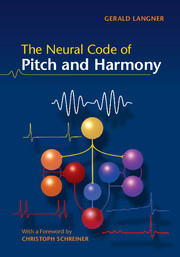Book contents
- Frontmatter
- Contents
- Preface
- Foreword
- 1 Historical aspects of harmony
- 2 Sound and periodicity
- 3 The discovery of the missing fundamental
- 4 The pitch puzzle
- 5 The auditory time constant
- 6 Pathways of hearing
- 7 Periodicity coding in the brainstem
- 8 Periodicity coding in the midbrain
- 9 Theories of periodicity coding
- 10 Periodotopy
- 11 The neural code of harmony
- 12 The oscillating brain
- References
- Index
Foreword
Published online by Cambridge University Press: 05 May 2015
- Frontmatter
- Contents
- Preface
- Foreword
- 1 Historical aspects of harmony
- 2 Sound and periodicity
- 3 The discovery of the missing fundamental
- 4 The pitch puzzle
- 5 The auditory time constant
- 6 Pathways of hearing
- 7 Periodicity coding in the brainstem
- 8 Periodicity coding in the midbrain
- 9 Theories of periodicity coding
- 10 Periodotopy
- 11 The neural code of harmony
- 12 The oscillating brain
- References
- Index
Summary
Human sensing abilities have been shaped and refined over long evolutionary periods. Hearing has adapted to serve us well in many different tasks and situations, helping us to orient ourselves and to survive in the world. The general properties of peripheral and central mechanisms of hearing are highly conserved across vertebrates due to very similar environmental conditions. Species specific variations do exist, such as the use of ultrasound for orientation in bats and cetaceans, but they are usually founded on quantitative and not qualitative differences to generally applicable principles of hearing and brain mechanisms. Basic hearing tasks for survival include detecting, localizing and identifying sound sources in cluttered or noisy environments. Another critical role of vertebrate hearing is the control and analysis of communication sounds which, in humans, lead to the highly developed ability of speech production and perception. Speech, like many other sounds involving resonance phenomena, contains harmonic elements, i.e. frequency components that are integer multiples of a common ‘fundamental’ frequency. These sounds can evoke a perceptual phenomenon, periodicity or virtual pitch that is distinct from other perceptual dimensions of sounds. A most human endeavour, the production and enjoyment of music, is fundamentally based on this perceptual phenomenon. Studies of the brain mechanisms that lead to this perception, its psychophysical manifestation and, eventually, cognitive and emotional benefits have progressed for more than a century, as is outlined in this volume, but still many aspects remain unresolved.
A helpful aspect in resolving this matter may be found in the fact that humans have surrounded themselves with an environment of their own creation. Based on our ability to use tools we have created artificial soundscapes that serve, entertain and move us. Unsurprisingly, many of those sound aspects have been, often inadvertently, chosen to match or most effectively engage our biological sound analysis system. Examples include the choice for frequency transitions in ambulance sirens to catch our attention, or the relationship of voices in polyphonic music.
- Type
- Chapter
- Information
- The Neural Code of Pitch and Harmony , pp. xiii - xivPublisher: Cambridge University PressPrint publication year: 2015



